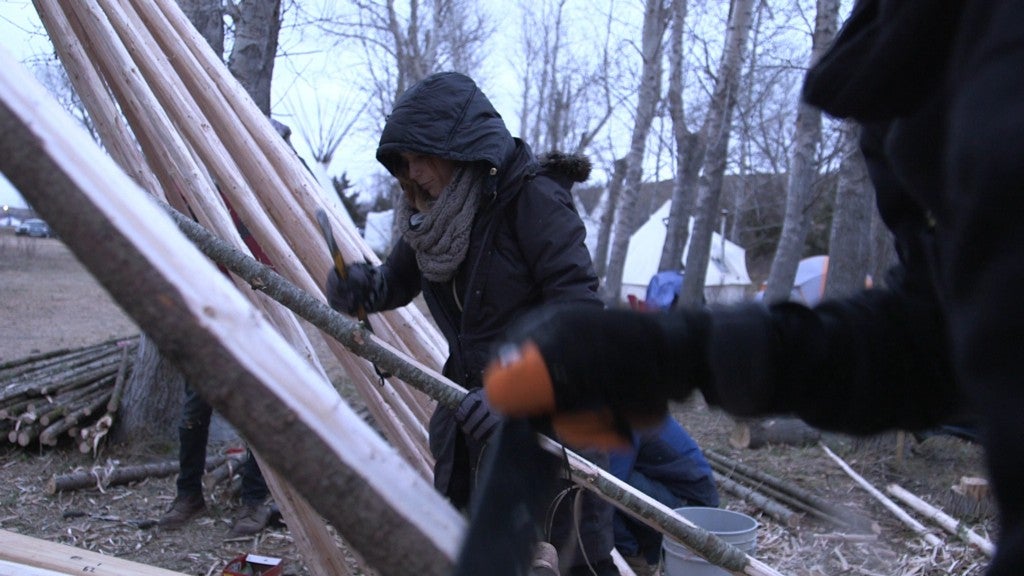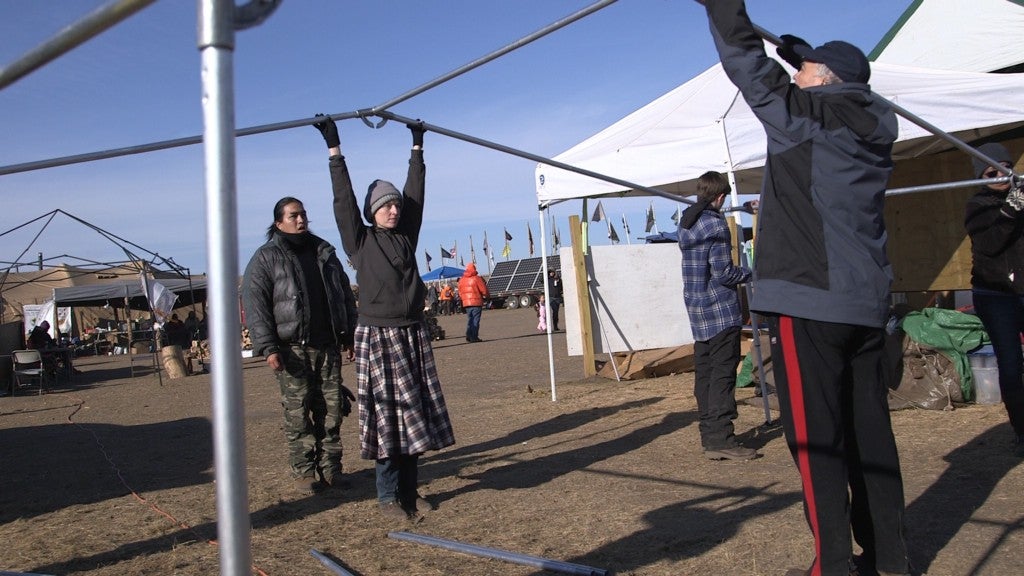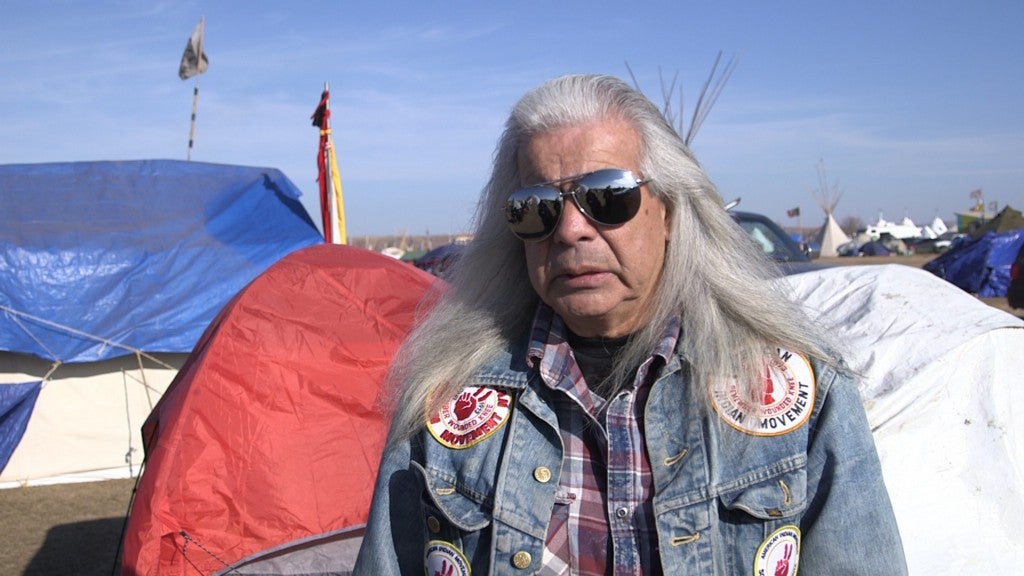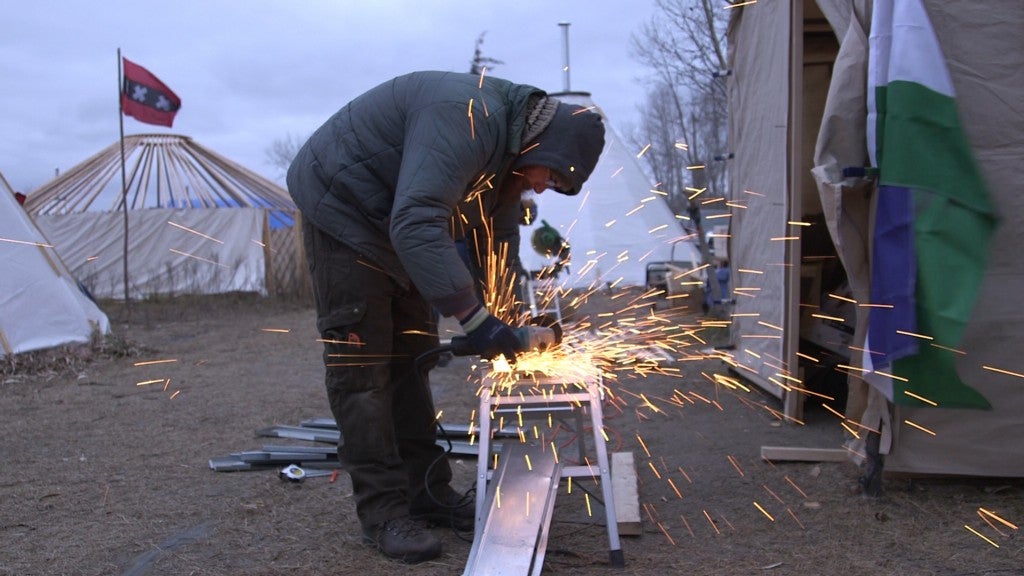First came the Standing Rock Sioux. Then the other tribes joined them. Then came the outsiders. Calling themselves “allies,” many drove up in Bernie-bumper-stickered cars, bringing donations of food to the camp, or wood to help make shelters for the ever-growing population. Veteran attendees of Burning Man and other festivals actually bring a useful expertise: making a temporary city. Many are highly skilled in construction and are helping to build housing as the North Dakota winter intensifies. Bundled-up crews of progressive whites from Seattle, men with beards and women with dyed-green hair, saw wood for “tarpees” — canvas teepees with wood stoves.
Most outsiders you talk to echo the almost identical, genuinely well-meaning, spiritual “call” to be here.

“It spoke to us; we felt like we had to do something,” says Caroline Tousignant, a waitress from Missouri who came with friends. She saved money to make the trip and borrowed camping supplies. “I couldn’t imagine what these people were going through; this is their land.”
For the most part, the indigenous people here appreciate the support. But the cultural differences have caused friction.
“It’s just very different from back home,” says Tousignant. “I’ve never been to a reservation before. People were very kind if we were doing something wrong. I feel a little bad because technically you’re supposed to be wearing skirts in this area if you’re a woman. We did not have any with us unfortunately.”
Every morning at 9 a.m., there’s an orientation session for anyone new to the camp. Cultural traditions are explained, as well as general rules: No filming anyone without his or her permission; no filming of prayer or ceremony. A sewing tent has been set up where visitors who don’t have long skirts can make them.
“It’s been an organic development of how to address [conflicts] as they come up,” says Danielle Gennety, who came to the camp in October. Gennety has a background in setting up festivals as well as a strong education in perma-culture and eco-friendly living.
“There have been significant issues raised with how non-natives walk here,” she says. “Because we’re so excited to share what we have and to step in and say — I can do this! I know how to do this! We have to ask permission first and not everyone knows to do that. So mistakes are made.”

Marcus “Quese IMC” Frejo, a member of the Wolf band of Pawnee and the Bear clan of Seminole, traveled here from Oklahoma in June to show solidarity with the Standing Rock Sioux. He’s set up an area within the camp for other Pawnee who visit. One evening he came home to find “four white kids in our camp,” he says, looking for a warm place to spend the night.
“I was trying to listen to my spirit,” Frejo says, “What should I do? And I knew it was cold outside.”
He told them he set the camp up as a spiritual place for other visiting Pawnee.
“The little white girl said, ‘Is it ok if we occupy your space?’” Frejo laughs. “I heard that word ‘occupy’ and I was like — man, we’re going to have an educational night here tonight.” He turned his attention to the young woman. “We won’t use that word ‘occupy,’” he says he told her. “Occupy is to take over a space that doesn’t belong to you.”
Frejo let the visitors stay, asked for their help in cleaning, and then spent time talking with them about the painful history of white people taking over indigenous space. He thinks of it now as an opportunity to help what he calls “our white allies.”
“We’re here to support the movement,” says Caleb Buchbinder, who traveled from Canada to be here. “This appears to be about a pipeline, but it’s really about people coming together and learning from each other.”
Talk to many of the indigenous people here though, and it is, in fact, very clearly about stopping a pipeline.
“I get tired of people saying, ‘I support you,’” says Graywolf, the director of the Southern California chapter of the American Indian Movement, who’s been living here at the camp.

“Oh, wonderful. I’m so happy that I have your support.” He rolls his eyes and laughs. “What I need is your action. Direct action is so important. Prayer is important. Trying to do this in a peaceful way is important. But the front line is important because that is what’s drawing attention to the situation.”
The media, he says, tends to only cover the demonstrations at Standing Rock when large groups of people turn out to gather by the barricades on Highway 1806, and when they are met with police violence.
Graywolf, who is 71, has been heading out to the front lines in peaceful demonstration every chance he gets.
“When non-native people come up to me and say, ‘What can we do?’ I say, ‘You need to not be our ally. We don’t need allies. We need accomplices.’ What that means is — you need to be on the front lines with us; you need to be out there battling with us,” he says.
Graywolf notices it happening more now. Outsiders who come to the camp may show up with a preconceived idea of what their contribution will be, and then pivot. One man came to the camp offering his chiropractic services. A woman who runs one of the kitchens here asked him to peel potatoes instead. He obliged.
“I’m not here to step on anyone’s toes,” says Abigail Porter, who came here from North Carolina. “I’m here to cultivate my listening skills and support whatever way I can—whether it’s helping, or holding someone or cooking food. I’m in the process of discovering my journey here. It’s about cultivating connection.”
Native activists are concerned about how the presence of so many outsiders can affect their land. “There’s a lot of waste. It’s a distraction from the water,” says Dave Archambault II, the chairman of the Standing Rock Sioux tribe. “If we’re about this environment, we would be protecting Mother Earth. We wouldn’t be hurting her. And yet, we’re punching holes all over down there [by pitching tents], in Mother Earth. That’s a sacred place. But there’s no regard.”
He worries about who is going to have to clean up the camp when everyone is gone, and that it will fall to him and the Standing Rock Sioux tribe.
Gennety is focusing on efforts to minimize waste at the camp.
“Bringing in all this canned food means we have a lot of cans,” she says. “All of this bottled water means we have a lot of bottles.”
At the dining hall tent she oversees, there are no plastic cups or paper plates. She asks that everyone show up with their own reusable mugs and dishes and wash them after. She used recycled pallets and 2-by-4s for housing.
“You can build a whole city with pallets!” she says.

The Army Corps of Engineers ordered construction of the 1,200-mile, $3.7 million pipeline from North Dakota to Illinois to be paused for environmental review and further consultation with the Standing Rock Sioux tribe (though most of the pipeline is complete). Energy Transfer Partners, the company building the pipeline, has filed suit against the Corps, saying that it’s a done deal and they have permission to complete the work.
Just last week, the Corps gave an “eviction notice,” saying that, for public safety reasons, everyone in the camps north of the Cannonball River must vacate by Monday, December 5. They added that they will not be forcibly removing anyone, but North Dakota’s governor sent out a mandatory evacuation order last night. So far, people are staying put.
New people are still coming to the camps. People who have left are coming back for a second or third time.
“They’re learning,” Graywolf says. “If you come with respect and learn our ways, then we have no problem with that. When people come here — there’s a thing called ‘white savior syndrome’ — and that’s white people who come to us and say, ‘We want to help you, but on our terms.’ We don’t need that. If you want to help us, it’s going to be on our terms. Because these are our issues, our land.”
There’s snow on the ground at Standing Rock now. As temperatures continue to drop, it remains to be seen how many people will stick around. Ultimately, the outsiders get to go home.
